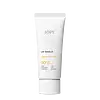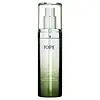What's inside
What's inside
 Key Ingredients
Key Ingredients

 Benefits
Benefits

 Concerns
Concerns

 Ingredients Side-by-side
Ingredients Side-by-side

Water
Skin ConditioningButylene Glycol
HumectantEthylhexyl Methoxycinnamate
UV AbsorberC12-15 Alkyl Benzoate
AntimicrobialBis-Ethylhexyloxyphenol Methoxyphenyl Triazine
Skin ConditioningDiethylamino Hydroxybenzoyl Hexyl Benzoate
UV FilterTitanium Dioxide
Cosmetic ColorantCyclopentasiloxane
EmollientNiacinamide
SmoothingDimethicone
EmollientSilica
AbrasiveCyclohexasiloxane
EmollientCetyl Alcohol
EmollientGlyceryl Stearate
EmollientPEG-100 Stearate
Trisiloxane
Skin ConditioningNylon-12
C14-22 Alcohols
Emulsion StabilisingPolyacrylate-13
Aluminum Stearate
Cosmetic ColorantParfum
MaskingPolyhydroxystearic Acid
EmulsifyingPolyisobutene
Alumina
AbrasiveStearic Acid
CleansingTocopheryl Acetate
AntioxidantC12-20 Alkyl Glucoside
EmulsifyingPolysilicone-11
C12-15 Alcohols
EmollientMethoxy PEG-114/Polyepsilon Caprolactone
BufferingGlyceryl Caprylate
EmollientBifida Ferment Lysate
Skin ConditioningCarbomer
Emulsion StabilisingCichorium Intybus Root Extract
MaskingEthylhexylglycerin
Skin ConditioningDisodium EDTA
Polysorbate 20
EmulsifyingAdenosine
Skin ConditioningSorbitan Isostearate
EmulsifyingPhenoxyethanol
PreservativeGossypium Herbaceum Extract
Skin ConditioningGlucose
HumectantSodium Benzoate
MaskingAcetic Acid
BufferingLactic Acid
BufferingTocopherol
AntioxidantWater, Butylene Glycol, Ethylhexyl Methoxycinnamate, C12-15 Alkyl Benzoate, Bis-Ethylhexyloxyphenol Methoxyphenyl Triazine, Diethylamino Hydroxybenzoyl Hexyl Benzoate, Titanium Dioxide, Cyclopentasiloxane, Niacinamide, Dimethicone, Silica, Cyclohexasiloxane, Cetyl Alcohol, Glyceryl Stearate, PEG-100 Stearate, Trisiloxane, Nylon-12, C14-22 Alcohols, Polyacrylate-13, Aluminum Stearate, Parfum, Polyhydroxystearic Acid, Polyisobutene, Alumina, Stearic Acid, Tocopheryl Acetate, C12-20 Alkyl Glucoside, Polysilicone-11, C12-15 Alcohols, Methoxy PEG-114/Polyepsilon Caprolactone, Glyceryl Caprylate, Bifida Ferment Lysate, Carbomer, Cichorium Intybus Root Extract, Ethylhexylglycerin, Disodium EDTA, Polysorbate 20, Adenosine, Sorbitan Isostearate, Phenoxyethanol, Gossypium Herbaceum Extract, Glucose, Sodium Benzoate, Acetic Acid, Lactic Acid, Tocopherol
Water
Skin ConditioningGlycerin
HumectantHydrogenated Poly(C6-14 Olefin)
EmollientPropanediol
SolventPentaerythrityl Tetraethylhexanoate
EmollientDimethicone
EmollientAgave Americana Leaf Extract
Skin ConditioningMilk Extract
Skin ConditioningMannitol
HumectantAcetyl Tetrapeptide-11
Skin ConditioningDipalmitoyl Hydroxyproline
Skin ConditioningAdenosine
Skin ConditioningPolyglyceryl-3 Methylglucose Distearate
EmulsifyingButyrospermum Parkii Butter
Skin ConditioningGlyceryl Stearate
EmollientHydrogenated Vegetable Oil
EmollientCetearyl Alcohol
EmollientGlyceryl Stearate Citrate
EmollientDimethicone/Vinyl Dimethicone Crosspolymer
Skin ConditioningSodium Polyacrylate
AbsorbentStearic Acid
CleansingPalmitic Acid
EmollientHydrogenated Polydecene
EmollientXanthan Gum
EmulsifyingGlyceryl Caprylate
EmollientButylene Glycol
HumectantCarbomer
Emulsion StabilisingTromethamine
BufferingEthylhexylglycerin
Skin ConditioningPPG-5-Laureth-5
EmollientDisodium EDTA
Parfum
MaskingWater, Glycerin, Hydrogenated Poly(C6-14 Olefin), Propanediol, Pentaerythrityl Tetraethylhexanoate, Dimethicone, Agave Americana Leaf Extract, Milk Extract, Mannitol, Acetyl Tetrapeptide-11, Dipalmitoyl Hydroxyproline, Adenosine, Polyglyceryl-3 Methylglucose Distearate, Butyrospermum Parkii Butter, Glyceryl Stearate, Hydrogenated Vegetable Oil, Cetearyl Alcohol, Glyceryl Stearate Citrate, Dimethicone/Vinyl Dimethicone Crosspolymer, Sodium Polyacrylate, Stearic Acid, Palmitic Acid, Hydrogenated Polydecene, Xanthan Gum, Glyceryl Caprylate, Butylene Glycol, Carbomer, Tromethamine, Ethylhexylglycerin, PPG-5-Laureth-5, Disodium EDTA, Parfum
Ingredients Explained
These ingredients are found in both products.
Ingredients higher up in an ingredient list are typically present in a larger amount.
Adenosine is in every living organism. It is one of four components in nucleic acids that helps store our DNA.
Adenosine has many benefits when used. These benefits include hydrating the skin, smoothing skin, and reducing wrinkles. Once applied, adenosine increases collagen production. It also helps with improving firmness and tissue repair.
Studies have found adenosine may also help with wound healing.
In skincare products, Adenosine is usually derived from yeast.
Learn more about AdenosineButylene Glycol (or BG) is used within cosmetic products for a few different reasons:
Overall, Butylene Glycol is a safe and well-rounded ingredient that works well with other ingredients.
Though this ingredient works well with most skin types, some people with sensitive skin may experience a reaction such as allergic rashes, closed comedones, or itchiness.
Learn more about Butylene GlycolCarbomer is a polymer of acrylic acid. Its main role is to create a gel consistency.
A high amount of carbomer can cause pilling or balling up of products. Don't worry, most products contain 1% or less of carbomer.
Dimethicone is a type of synthetic silicone created from natural materials such as quartz.
What it does:
Dimethicone comes in different viscosities:
Depending on the viscosity, dimethicone has different properties.
Ingredients lists don't always show which type is used, so we recommend reaching out to the brand if you have questions about the viscosity.
This ingredient is unlikely to cause irritation because it does not get absorbed into skin. However, people with silicone allergies should be careful about using this ingredient.
Note: Dimethicone may contribute to pilling. This is because it is not oil or water soluble, so pilling may occur when layered with products. When mixed with heavy oils in a formula, the outcome is also quite greasy.
Learn more about DimethiconeDisodium EDTA plays a role in making products more stable by aiding other preservatives.
It is a chelating agent, meaning it neutralizes metal ions that may be found in a product.
Disodium EDTA is a salt of edetic acid and is found to be safe in cosmetic ingredients.
Learn more about Disodium EDTAEthylhexylglycerin (we can't pronounce this either) is commonly used as a preservative and skin softener. It is derived from glyceryl.
You might see Ethylhexylglycerin often paired with other preservatives such as phenoxyethanol. Ethylhexylglycerin has been found to increase the effectiveness of these other preservatives.
Glyceryl Caprylate comes from glycerin and caprylic acid, a fatty acid from coconut. It has emollient and emulsifier properties.
As an emollient, it helps hydrate your skin. Emollients work by creating a barrier on your skin to trap moisture in, helping to keep your skin soft and smooth.
On the other hand, emulsifiers prevent ingredients (such as oil and water) from separating.
Learn more about Glyceryl CaprylateGlyceryl Stearate is a mix of glycerin and stearic acid.
It is used to stabilize the mixing of water and oil ingredients. By preventing these ingredients from separating, it can help elongate shelf life. It can also help thicken the product's texture.
As an emollient, it helps soften skin and supports barrier-replenishing ingredients.
In cosmetics, Glyceryl Stearate is often made from vegetable oils or synthetically produced.
This ingredient may not be fungal-acne safe
Fun fact: The human body also creates Glyceryl Stearate naturally.
Learn more about Glyceryl StearateParfum is a catch-all term for an ingredient or more that is used to give a scent to products.
Also called "fragrance", this ingredient can be a blend of hundreds of chemicals or plant oils. This means every product with "fragrance" or "parfum" in the ingredients list is a different mixture.
For instance, Habanolide is a proprietary trade name for a specific aroma chemical. When used as a fragrance ingredient in cosmetics, most aroma chemicals fall under the broad labeling category of “FRAGRANCE” or “PARFUM” according to EU and US regulations.
The term 'parfum' or 'fragrance' is not regulated in many countries. In many cases, it is up to the brand to define this term.
For instance, many brands choose to label themselves as "fragrance-free" because they are not using synthetic fragrances. However, their products may still contain ingredients such as essential oils that are considered a fragrance by INCI standards.
One example is Calendula flower extract. Calendula is an essential oil that still imparts a scent or 'fragrance'.
Depending on the blend, the ingredients in the mixture can cause allergies and sensitivities on the skin. Some ingredients that are known EU allergens include linalool and citronellol.
Parfum can also be used to mask or cover an unpleasant scent.
The bottom line is: not all fragrances/parfum/ingredients are created equally. If you are worried about fragrances, we recommend taking a closer look at an ingredient. And of course, we always recommend speaking with a professional.
Learn more about ParfumStearic Acid is a fatty acid. It is an emollient, emulsifier, and texture enhancer.
As an emollient, stearic acid helps soften skin. It aids the skin's protective barrier by preventing water loss. It also provides a gentle cleansing effect without stripping away natural oils.
Stearic acid may also be used to enhance the texture of products. It can add volume and stabilize ingredients such as water and oil. This can help water and oil ingredients from separating.
Sources of stearic acid include animal or vegetable fats/oils such as coconut or shea. It can be naturally found in butter, cocoa butter, shea butter, vegetable fats, and animal tallow.
This ingredient may not be Malassezia folliculitis, or fungal-acne safe.
Learn more about Stearic AcidWater. It's the most common cosmetic ingredient of all. You'll usually see it at the top of ingredient lists, meaning that it makes up the largest part of the product.
So why is it so popular? Water most often acts as a solvent - this means that it helps dissolve other ingredients into the formulation.
You'll also recognize water as that liquid we all need to stay alive. If you see this, drink a glass of water. Stay hydrated!
Learn more about Water